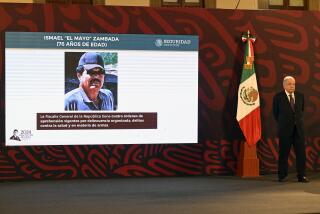U.S. Aided Philippine Rebel Move : Weinberger, Crowe Confirm Helicopter Support, Mediation
- Share via
WASHINGTON — American forces in the Philippines gave logistical support to rebel-piloted helicopter gunships during the face-off between troops loyal to deposed President Ferdinand E. Marcos and the military faction that supported Corazon Aquino, Defense Secretary Caspar W. Weinberger said Sunday.
On the CBS-TV program “Face the Nation,” Weinberger confirmed reports of what he called limited U.S. “aid and comfort” to the anti-Marcos faction during the three-day crisis last week that ended in Marcos’ abdication and flight. He said that the prime American policy objective was to avoid a violent confrontation that could have led to civil war.
Making a similar point on NBC’s “Meet the Press,” Adm. William J. Crowe Jr., chairman of the Joint Chiefs of Staff, confirmed that U.S. military facilities were used to keep communications open between the opposing forces, which was a factor in the relatively bloodless outcome.
Reports Confirmed
Weinberger’s and Crowe’s statements were the official confirmation of reports widely circulated in the Philippines that the U.S. military played a role in last week’s events in Manila.
Crowe flatly denied, however, that any U.S. military force was deployed on behalf of the anti-Marcos faction. “I think our position throughout was that we were in contact with both sides. . . ,” he said. “Our general posture and our goal throughout was to avoid bloodshed.”
Crowe added: “We were facilitating messages back and forth between both groups to make sure they understood each other. And I think that was a proper and appropriate mission.”
‘Giving Aid and Comfort’
Using almost identical language, Weinberger explained that “we were giving aid and comfort . . . and encouragement, really, to anything that would eliminate the violence or the threat of bloodshed.”
But Weinberger went on to point out that when the anti-Marcos forces--headed by Defense Minister Juan Ponce Enrile and Lt. Gen. Fidel V. Ramos, Marcos’ deputy chief of staff--first set up makeshift headquarters, they could command barely 1,500 to 2,000 men.
“It was very important that that group in this camp . . . not be attacked,” Weinberger said. “When you have a group of 2,000 people held up in a military camp from which they could easily be attacked by a large force--and there were larger forces under Ver (Marcos loyalist Gen. Fabian C. Ver, then army chief of staff) at that time--that would have been a very, very bloody scene.
“So, we wanted to do everything we could to prevent that, and the presence of the helicopters over this group (the rebels) could well have discouraged any sort of attack.”
Six Gunships
Last Monday, in the tension that gripped the country before Marcos departed, six helicopter gunships of the Philippine army’s 15th Air Wing hovered over rebel-held Camp Crame at dawn, then landed without firing a shot. Their pilots declared that they had defected to the anti-Marcos cause.
Those gunships, which apparently were refueled and serviced at a U.S. base, later were instrumental in bringing Marcos to realize that his forces could not prevail.
Another witness to that critical period was Sen. Paul A. Laxalt (R-Nev.) who served as a close, informal intermediary between President Reagan and Marcos during the crisis.
Laxalt has several times recounted publicly how late Monday afternoon in Washington--5 a.m. Tuesday, Manila time--he advised a dispirited and disillusioned Marcos that it was time to “cut and cut cleanly.”
Confrontation Feared
Recalling that conversation Sunday over NBC’s “One on One,” Laxalt disclosed that in an earlier talk about 3 a.m. Tuesday, Manila time, Marcos left him with the belief that a bloody confrontation was unavoidable.
“He was still confident,” Laxalt said. “He wasn’t going to give up. Something had to be worked out. He had 85% of the army. And that frightened the daylights out of me because he appeared in that first conversation to be almost in a conversational mode, which meant that we were going to have a blood bath.”
Laxalt praised Marcos’ restraint at the end, alluding to the preponderance of force on Marcos’ side and Ver’s advice to use it. He noted that Marcos could have deployed his air force and artillery against the small military faction opposing him and the massive crowds in the streets of Manila.
‘Could Have Used Big Guns’
“He could have used the big guns. He could have strafed,” Laxalt said. “He had Ver and other people saying strafe the camp (Crame). He really, right down to the end, could have had a tremendous demonstration of force. He could have caused thousands of people to be slaughtered.”
Meanwhile, the Associated Press reported that Congress will receive a classified document from the Pentagon today estimating that it would cost more than $8 billion to relocate two large U.S. military bases in the Philippines.
The Pentagon document says that if the two bases are lost, the most stable potential relocation spots are Guam and Tinian islands, a long distance from potential hot spots, AP quoted unidentified sources as saying.
The bases, Clark Air Base and Subic Bay Naval Base, are the largest American military installations outside the United States. Leases on them expire in 1991.
More to Read
Sign up for Essential California
The most important California stories and recommendations in your inbox every morning.
You may occasionally receive promotional content from the Los Angeles Times.













